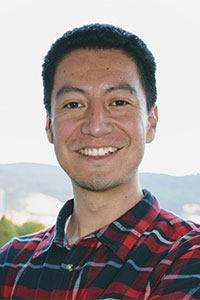Juan Caicedo, a computer scientist employing machine learning to decode complex patterns in human biology, will join the Morgridge Institute for Research this summer as a biomedical imaging investigator.

Caicedo, currently a Schmidt Fellow at the Broad Institute of MIT and Harvard, will also join the faculty of biostatistics and medical informatics at the University of Wisconsin–Madison. Caicedo invents computer vision tools to analyze vast amounts of biological data — in some cases, millions of cellular images — to recognize patterns that could be meaningful to human disease.
Biomedical imaging is a thriving research community at Morgridge and UW–Madison, with hundreds of scientists working on microscopy and computation innovations to better understand basic biology. Caicedo says Madison will be an ideal place to take his research to new levels in collaboration with biomedical and computer scientists.
“I really appreciate having the support of a private institute to do research that is kind of risky,” Caicedo says of Morgridge. “And I like the institute’s vision of ‘fearless science,’ in which you can really go after the most difficult challenges that may be hard to approach with traditional ways of conducting research. I like the freedom to explore new ideas and embrace new challenges.”
Caicedo has a diverse background in machine learning research. When working on his computer science Ph.D. at National University of Colombia, Caicedo became captivated by new tools for object detection and facial recognition. For his Ph.D. research, he worked with a pathology lab to apply some of these nascent techniques to pattern recognition in diseased cells.
As a Ph.D. student, he was a visiting researcher at Queen Mary University of London, and was able to pursue internships with tech giants Microsoft and Google, working on enhancing and classifying images. Then he joined the University of Illinois Urbana-Champaign as a postdoc, where he developed an influential algorithm for object detection in internet images.
Caicedo could have joined the private sector, but was still inspired by those first projects in Colombia related to human health. Fortunately, he found an ideal position at Broad that was devoted to biological image analysis.
“Juan brings a fantastic skill set to Wisconsin that taps into both biomedical imaging and research computing, two major areas of strength at Morgridge, and areas of growth campus-wide with the new computer and data science institute building on the horizon.”
Brad Schwartz
Caicedo says that, as humans, every time we encounter some kind of obstacle, we are driven to invent new tools to overcome them — whether it be microscopes to see biology, telescopes to see outer space or machines to build cities. As skilled as pathologists and medical experts are in today’s age, Caicedo says their chief obstacle —the limitations of human vision — motivate us to turn to computation for answers.
“In terms of decoding biology, we may not be able to see all the structural patterns of cells that matter in order to design treatments, or to fight viruses or to kill diseases,” he says. “But we may be able to create the tools that can help us decode those specific patterns, understand them in a more scalable way so we can really address the more pressing issues in health.”
One productive example in Caicedo’s lab concerns cancer mutations. His team studied genetic mutations from tumors of cancer patients that were sequenced to identify their functional impact. Finding those mutations linked to cancer proliferation gives clinicians a potential target for new therapies and treatments.
The obstacle, in this case, is that there are potentially hundreds of interrelated mutations in cancer cells, and we understand only a fraction of them, Caicedo says. Furthermore, some mutations might be neutral and cause no harm, while others may be side effects of the cancer itself and not the cause.
To approach this challenge, Caicedo’s team at the Broad Institute designed an experiment to artificially introduce hundreds of mutations into cells, one at a time, and then analyze the imaging data through machine learning. They scanned images of cells to study as many as 300 mutations in a single experiment. Then they developed automatic methods to detect the phenotypes expressed in these different mutations, helping identify the important ones more rapidly and efficiently.
Brad Schwartz, CEO of the Morgridge Institute, says Caicedo’s research is like bringing together “an army of pathologists” to study disease in a more systematic way. “Juan brings a fantastic skill set to Wisconsin that taps into both biomedical imaging and research computing, two major areas of strength at Morgridge, and areas of growth campus-wide with the new computer and data science institute building on the horizon.”
Caicedo says he is very excited about working with the Morgridge Research Computing team, which pioneers the use of high-throughput computing across nearly all research disciplines. “Having that specific expertise and infrastructure around it was kind of the cherry on top of the cake,” he says.
As an underrepresented minority in science, Caicedo is passionate about issues related to diversity, equity and inclusion (DEI) in the science workplace. At Broad, he became involved in a group devoted to women in science, which had taken an early lead on addressing questions of representation that were important to him. He later became deeply involved in a Broad effort called IDEA Ambassadors, which stands for inclusion, diversity, equity and allyship. He hopes to continue those efforts at Morgridge.
